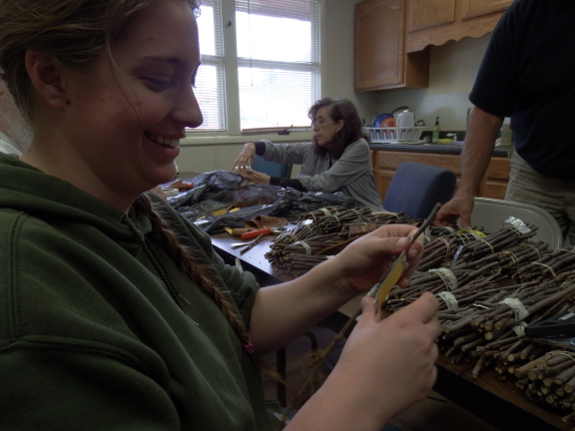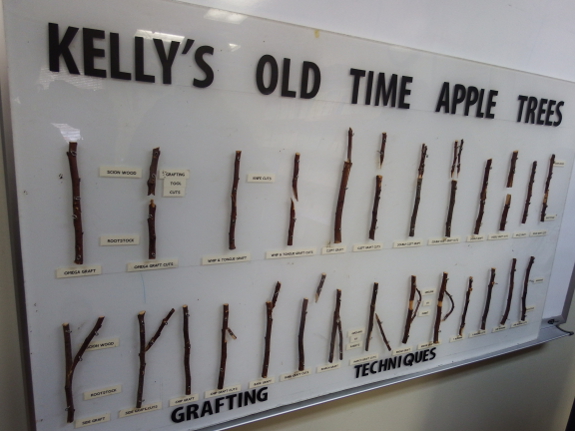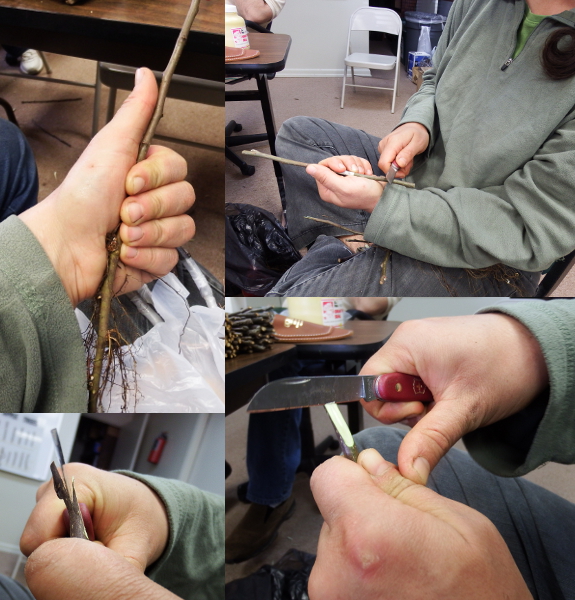
Apple grafting tips

Kayla and I enjoyed a girl's day out Thursday --- we attended the annual grafting workshop
at the Gate City extension office. I've been to nearly half a dozen
grafting workshops now, and this one was by far my favorite. Not only
was it held at 2 pm so we could get home before dark, but the selection
of scionwood was astounding. I came in the door with nine pieces of
scionwood I'd brought from winter trades, planning to just graft what I
had...but I walked out with sixteen apple trees. (Good thing they were
willing to sell me extra rootstock for a dollar a pop.)

In addition to the copious scionwood choices, the organizers had three
apple books on hand, so I could look up each variety to see whether it would hit the spot. Yes, I did spend
an hour paging through the books to determine which types of apples were
worth a try. Even though the pages were simply text, I found the most complete book was Fruit, Berry, & Nut Inventory --- I may have to get a copy for future variety selection.
As a side note, I should mention that half of the instruction and most of the scionwood came courtesy of Kelly's Old Time Apple Trees, whose website is rather sparse but who sells both scionwood and full apple trees to ship across the country. Our wedding apple trees came from Kelly's and the fruits are superb! If you don't want to go through the hassle of swapping for scionwood, then Kelly's may be your one stop shopping outlet.

But the positive points
of this workshop went far beyond excellent scionwood selection and a
good time of day. The instructors were also pros who helped me learn
safer and more effective methods of making the classic whip-and-tongue
graft. First, start with their "rule of thumb" --- grasp the rootstock
where the top roots branch off, then cut off the top where the tip of
your thumb reaches. (I figured my thumb was a little shorter than the
digits on their male hands, so cut just a little higher.)
Next (top right photo), hold your knife in your right hand so the beveled edge is up and don't move that hand.
It feels awkward at first, but you'll soon learn how to hold the
rootstock in your left hand with the roots facing away from your body so
you can pull the rootstock away from you against the stationary knife.
This is much safer and makes a much straighter cut than the whittling
method I'd been using.
Finally, for the tongue,
brace the thumb of your knife hand against your other hand (which,
again, feels quite awkward at first), and gently pull the knife into the
wood by sawing it back and forth. Once the knife is seated, finish the
cut by rocking the knife rather than pulling it down. Then slide the two
pieces of wood together, seal them well with grafting tape, cut down to two buds on the scionwood, dab some sealer on the cut end, and you're done!
I'm still far from
perfect, but after sixteen trees, I was starting to feel pretty
proficient. Good thing too since I suspect this will be my last grafting
workshop for a while --- I'm finally running out of spots to put new
trees. Kayla and I are going to have to think of a new girl's day out
plan for next year.
Want more in-depth information? Browse through our books.
Or explore more posts by date or by subject.
About us: Anna Hess and Mark Hamilton spent over a decade living self-sufficiently in the mountains of Virginia before moving north to start over from scratch in the foothills of Ohio. They've experimented with permaculture, no-till gardening, trailersteading, home-based microbusinesses and much more, writing about their adventures in both blogs and books.
Want to be notified when new comments are posted on this page? Click on the RSS button after you add a comment to subscribe to the comment feed, or simply check the box beside "email replies to me" while writing your comment.

I love that you spend a girls-day out grafting apple trees! I am going to have to try and make it next year to acquire some for our orchard too
When you are considering where to place these on your homestead, do you try to cluster the early-mid-late season varieties close to one another to ensure good pollination? or do you have crabapples interspersed among the different varieties so that they all have nearby pollinators?
I am sure you have some sort of spreadsheet or tracking device already well in hand to capture each tree's growth and production, and I know I would love to see what you use. I have spent many mornings trying to determine what would be the best way to manage the data of how each variety we will plant does in the face of our changeable weather patterns through the years.
It's another precious sunny day, so when you come back from being in the garden, I look forward to your answer! Cheers!